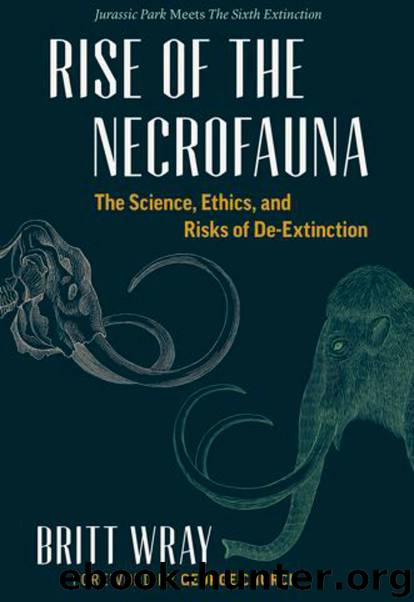Rise of the Necrofauna by Britt Wray

Author:Britt Wray
Language: eng
Format: epub
Publisher: Greystone Books
Published: 2017-11-15T05:00:00+00:00
PASSENGER PIGEON
Passenger pigeons ate a great many things, though it was observed that the fruits of hard-mast trees were their favorite food. However, that might have just been a byproduct of how abundant the trees that produce hard mast have been over the last 10,000 years. When the birds had their pick, they’d go straight for beechnuts, acorns, and at times chestnuts, which their flexible jaws and elastic throats allowed them to swallow whole. Some bird throats, like the passenger pigeon’s, include a special pouch called a crop—a pocket-like area that can store food before the bird begins to digest it. The passenger pigeon’s crop could hold up to half a cup of nourishment. Once it was full, it bulged out twice as wide as the bird’s body. If a pigeon happened to be shot while it was in this stuffed state, records say, it would crash to the ground with the sound of a sack of marbles hitting the floor.
When the hard mast (acorns and so on) wasn’t available, passenger pigeons would munch on locusts, various insect larvae, earthworms, and snails. Their devoted historian, Joel Greenberg, has found records of at least forty-two genera of wild plants they would eat, which isn’t even counting the domestic plants—like buckwheat, rye, corn, hemp, and wheat—that they also picked away at.
But while passenger pigeons were busy looking for food, we were looking at them as food. “You could go into these huge breeding colonies, and you could smoke them out,” Peck tells me. “You could shoot as many as twenty to twenty-five birds with a single shot. They would quickly have their feathers removed, be stuffed into barrels and salted.” Greenberg puts the number even higher, noting that records say as many as ninety-nine birds could be shot at once. The young ones—the squabs—generally had a lot of fat on them, which made life a little easier when they first left the nest. Unfortunately for them, it also meant that they tasted better to us humans. Fatty squab was a common menu item in fine restaurants in New York, Chicago, and Toronto. Holding a stiffened bird in each hand, Peck looks at me with subtle mourning in his eyes and says, “There are stories about trains carrying nothing but passenger pigeons down to some of the bigger cities in barrels.”
The first comprehensive study of the passenger pigeon’s extinction was produced by an American chemical researcher named Arlie William Schorger and published in 1955. From the copious records Schorger collected, he was able to show that it was common opinion in the United States that fatty pigeons tasted best. The ones that fed on beechnuts were especially desirable for fine dining, since they were rich in tasty lipids. In order of preference, according to Schorger’s records, human eaters seemed to like squabs first, birds raised in captivity second, and those that were hunted in the months of September and October third. Sometimes the birds were captured alive and moved into cages for fattening before they were eaten later in the winter.
Download
This site does not store any files on its server. We only index and link to content provided by other sites. Please contact the content providers to delete copyright contents if any and email us, we'll remove relevant links or contents immediately.
Sapiens: A Brief History of Humankind by Yuval Noah Harari(14252)
The Tidewater Tales by John Barth(12608)
Mastermind: How to Think Like Sherlock Holmes by Maria Konnikova(7227)
Do No Harm Stories of Life, Death and Brain Surgery by Henry Marsh(6891)
The Thirst by Nesbo Jo(6828)
Why We Sleep: Unlocking the Power of Sleep and Dreams by Matthew Walker(6618)
Life 3.0: Being Human in the Age of Artificial Intelligence by Tegmark Max(5474)
Sapiens by Yuval Noah Harari(5294)
The Longevity Diet by Valter Longo(5021)
The Body: A Guide for Occupants by Bill Bryson(4974)
The Rules Do Not Apply by Ariel Levy(4861)
The Immortal Life of Henrietta Lacks by Rebecca Skloot(4525)
Animal Frequency by Melissa Alvarez(4395)
Why We Sleep by Matthew Walker(4360)
The Hacking of the American Mind by Robert H. Lustig(4318)
Yoga Anatomy by Kaminoff Leslie(4306)
All Creatures Great and Small by James Herriot(4233)
Double Down (Diary of a Wimpy Kid Book 11) by Jeff Kinney(4207)
Barron's AP Biology by Goldberg M.S. Deborah T(4097)
